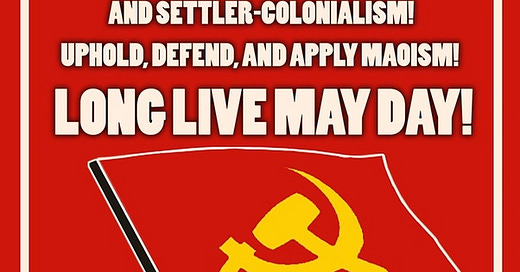Workers of the World, Unite!
May 1st is International Workers' Day, the day we celebrate and remember the long history of proletarian class struggle! From the foundation of the Communist League until today, we have seen how the proletariat and its allies have waged war on their class enemies, namely the big bourgeoisie and its allies. There were many twists and turns, advances and retreats, victories and defeats, etc. that our movement has faced. We strongly encourage studying revolutionary communist theory and practice (by studying history) to combat anti-communist myths and to know what is to be done today. (We have many articles, especially on history, but we urge people to study theory from its primary sources, especially the classics of Marxism.)
The workers started with trade unions, workers’ parties, etc. that attempted to attack capitalist exploitation on small levels. Following that, the Paris Commune of 1871 became the first proletarian state. Later on, the October Revolution created the first long-lasting socialist state, the Union of Soviet Socialist Republics. Despite imperialist attacks and internal class enemies’ attempts at counter-revolution, the USSR survived and developed its productive forces to the level needed to withstand Operation Barbarossa, the largest military operation in human history. It militarily supported Eastern Europe’s liberation, creating people’s democracies there; it also supported Asian struggles, creating the Democratic People’s Republic of Korea and the People’s Republic of China. After that, the Democratic Republic of Vietnam was founded. At that point, our class had power over much of Europe and Asia; over one billion people—in a time when the world population had just reached three billion—were liberated from the shackles of imperialism, feudalism, and bureaucratic-comprador capitalism! In the late-1960s through the 1980s, new revolutions began the world over, especially in India, the Philippines, Turkey, and Peru; both the revolutions of the Philippines and Peru were able to take a majority of their countries’ land, and India and Turkey had similar periods of success in building new power.
Despite this series of successes, there were numerous defeats, errors, mistakes, crimes, and so on. The Second International had troubles as revisionism grew in its parties; Lenin and his party defended Marxism from that bourgeois ideology, but the shit revisionism created has lasted to this day. The October Revolution’s success was met with failures of revolutions in Germany and Hungary as well as failures to have revolutions in other, more-developed capitalist countries. Yugoslavia, a country whose people freed themselves from fascist imperialism without large Soviet aid, fell to revisionism and social-fascism in 1948–49; the USSR and many other people’s democracies took that revisionist road in 1953–56, leaving China and Albania as the only socialist states around. Eventually, China turned capitalist, and then Albania did so as well, leaving no socialist state around today. The revolutions we described above faced hard hits and heavy blows from imperialists and their compradors, and now, the Peruvian, Turkish, and Indian people’s powers are fractions of what they used to be. Nepal had its own revolution that entirely capitulated to revisionism, too.
But again, we must be revolutionary optimists. The revolutions that happen today are not dead, but they are regaining control and taking new actions against their states; around the world, the working people are being radicalized because capitalist-imperialism is exploiting and immiserating them, and it is causing the climate crisis that is happening right now. Marxism-Leninism-Maoism is rising in support while people are disillusioned by opportunists’ failures to make progress. This trend may continue, but only if we all do our parts in studying theory and history as well as practicing what we learn by doing mass work!
Long live Marxism-Leninism-Maoism! Down with capitalism, feudalism, and imperialism! Workers of the world, unite!




